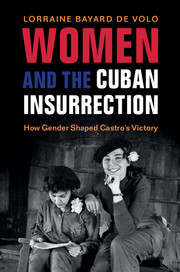Book contents
- Women and the Cuban Insurrection
- Women and the Cuban Insurrection
- Copyright page
- Dedication
- Contents
- Preface
- 1 Revolution Retold
- 2 “How Can Men Tire When Women Are Tireless?”
- 3 A Movement Is Born
- 4 Abeyance and Resurgence
- 5 Gendered Rebels
- 6 War Stories Celebrated and Silenced
- 7 “Stop the Murders of Our Children”
- 8 Masculinity and the Guerrilla War of Ideas
- 9 Women Noncombatants
- 10 Las Marianas
- 11 Past Is Prologue
- Bibliography
- Index
4 - Abeyance and Resurgence: Sustaining Rebellion in Prison and Exile
Published online by Cambridge University Press: 19 January 2018
- Women and the Cuban Insurrection
- Women and the Cuban Insurrection
- Copyright page
- Dedication
- Contents
- Preface
- 1 Revolution Retold
- 2 “How Can Men Tire When Women Are Tireless?”
- 3 A Movement Is Born
- 4 Abeyance and Resurgence
- 5 Gendered Rebels
- 6 War Stories Celebrated and Silenced
- 7 “Stop the Murders of Our Children”
- 8 Masculinity and the Guerrilla War of Ideas
- 9 Women Noncombatants
- 10 Las Marianas
- 11 Past Is Prologue
- Bibliography
- Index
Summary
After scores of rebel men died in the 1953 assault on the Moncada barracks and the remainder were imprisoned or exiled, the rebel movement fell into a three-year period of abeyance. Haydée Santamaría and Melba Hernández, released from prison after seven months and commanding new status in the resistance, were crucial to implementing Fidel Castro's orders, presenting the public face of the movement, and developing new alliances and broad-based support. Many other women followed Melba and Haydée's lead, mobilizing to support Fidel's cause.
Abeyance periods are not unusual in a movement's lifecycle. They are a holding pattern, a phase during which movements “scale down and retrench to adapt to changes in the political climate.” Research on movement abeyance is thus far based on cases of social movements in stable democracies, not armed insurrection. Cuba presents a very different setting, in which abeyance was imposed through military defeat, death, imprisonment, and exile. For its part, the scholarly literature on the Cuban insurrection has typically paralleled the Cuban War Story in passing over this phase to focus on the periods of armed conflict, which in effect has meant that this period in which women were primary protagonists has often been overlooked.
In this chapter, we see that the early and unconventional inclusion of women gave the rebels a series of advantages that helped ensure the rebel resurgence in December 1956. With the capture, exile, and killing of so many rebel men in 1953, Castro relied heavily on women, a position complemented by a rebel commitment to equality. Though Castro was more progressive than the Batista regime in recognizing women as political agents, he nonetheless barred women from the riskiest assignments. The result, when combined with state forces' traditional gendered notions of women as apolitical, was that rebel women leaders survived and emerged from prison before rebel men with the skills and status to sustain the movement in abeyance, accompanied by newly mobilized women.
As rebel tactics in this period revolved around building alliances and disseminating Castro's revolutionary vision, Haydée and Melba were the face of the movement, implementing the orders of their imprisoned and then exiled leader, developing activist networks, and cultivating a rebel collective identity.
- Type
- Chapter
- Information
- Women and the Cuban InsurrectionHow Gender Shaped Castro's Victory, pp. 65 - 87Publisher: Cambridge University PressPrint publication year: 2018



